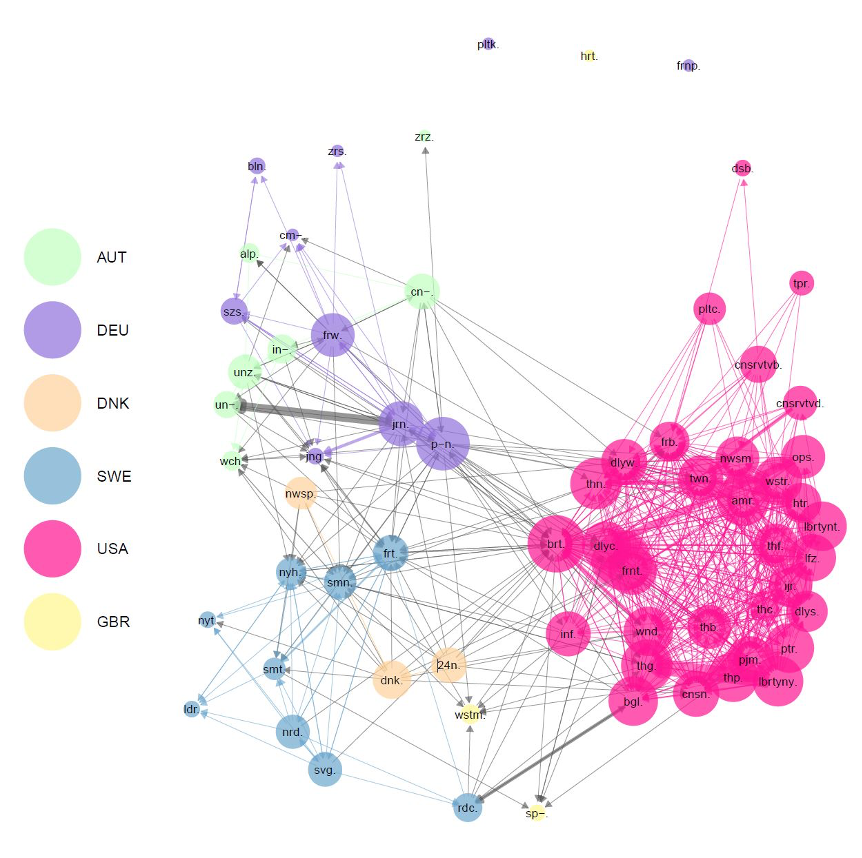by Eva Mayerhöffer
Just in time for the European Parliament Election 2019, a somewhat notorious figure made a public re-appearance. Steve Bannon, the co-founder of alt-right news site Breitbart News and former chief strategist for the Trump administration, embarked on a mission to foster a global right-wing populist movement (https://www.nytimes.com/2018/03/09/world/europe/horowitz-europe-populism.html). Europe was supposed to be the first step.
The Movement, as it was called, never really took off – that it should require an American to ‘save’ Europe was too much to swallow for European nationalists after all. Yet, while Steve Bannon may have failed on the political scene, chances are he has fostered the global alt-right movement on a whole other level. In the past couple of years, many countries around the globe have seen the emergence of online news media that position themselves as a counterforce to a perceived liberal mainstream in media and politics. Many of these right-wing alternative (or ‘alt-right’) online news media have not least been inspired by Bannon’s brainchild Breitbart News.
Is it maybe through these news sites that we can see a transnational alt-right movement emerging? And how transnationally oriented are these news sites in the first place? Can we find evidence for an emerging network of right-wing online news sites across countries? We tried to answer these questions by focusing on alternative news sites from six different countries – the US, the UK, Sweden, Denmark, Germany and Austria. With the US and Sweden, the selection includes two countries that are frequently named as ‘exporters’ of alt-right ideology, as well as three country pairs of (cultural) neighbors. That right-wing news sites from precisely these countries should entertain at least some relations with each other across borders is thus not unlikely.
As most of these news sites are online native and rely heavily on social media as a dissemination platform, digital methods naturally played an important part in data collection and analysis. In assessing the transnational networking potential of these sites, we focused on two aspects in particular: 1) We looked at whether they re-tweeted posts of or mentioned other right-wing news sites on Twitter. To do so, we harvested mention and re-tweet activity of in total 65 sites through DMI-TCAT-user, hosted by RUC’s Digital Media Lab (https://digitalmedialab.ruc.dk/hosted-resources/). 2) We also studied whether they hyperlinked to other right-wing news sites in article content published on their websites. As alternative news sites are not regularly included in media archives such as Infomedia or Lexis Nexis, we collected article hyperlinks through the platform MediaCloud.org, which collects online news stories through the RSS feed of online media sources. To scrape all hyperlinks embedded in these articles, we used the R package ‘rvest’.
Why not Facebook? As many of these sites use Facebook almost exclusively as a platform to disseminate their website article content, collecting website hyperlinks through extracting data from Facebook’s API would indeed have been a viable alternative. Not least because it would provide the possibility to include audience engagement patterns in the analysis, as well. Unfortunately, apps to do so, e.g. DMI’s Netvizz Application, are now no longer allowed on Facebook.
But back to the question of transnational networks among right-wing news sites. To understand their linking behavior better, we have to quickly consider why right-wing news sites may be inclined to refer to other alternative news sites in the first place. Very broadly, we can distinguish between two strategies. On the one hand, right-wing news sites may refer to each other based on a movement logic. This means that they predominantly perceive themselves as part of a larger right-wing movement beyond the conservative mainstream that includes actors and organizations from the populist right-wing, ‘alt-right’, far right and extreme right spectrum. Hyperlinks, mentions and re-tweets serve here to cement political alliances, to build and reinforce a group identity, as well as to increase the visibility and exaggerate the importance of issues relevant to the movement. On the other hand, alt-right news sites may link to other sites based on a professional logic. By hyperlinking to additional material in articles, the sites can seek to heighten the article’s concision and depth through background information. So-called citational links to the original producer of news or other materials demonstrate facticity and strengthen thereby the credibility of an article and the entire website. The higher the societal status and overall credibility of the linked source, the higher the chances that the linking practice enhances one’s own reputation.
But why link to right-wing news sites from abroad? For one, it has been argued that transnational networking is particularly relevant when the national alternative digital news environment is relatively underdeveloped, as it is e.g. the case in Denmark. Secondly, including sources from abroad widens the spectrum of news stories of partisan news value. A typical news story featured on these sites is e.g. a criminal offense committed by immigrants. Yet, even though these sites are working hard to suggest otherwise, these offenses do not come in infinite numbers. And where are additional stories easier to find than on alt-right news sites from other countries? Finally, alt-right news sites may perceive themselves in competition with each other on the national level, but less so on the transnational level, and thus be more prone to refer to each other here.
Over the course of a 3-month period, we managed to extract more than 700,000 relevant hyperlinks (that is excluding links to e.g. advertisement or social media platforms) from articles published by the 65 right-wing alternative websites. Roughly 24,000 of those were connections between these 65 sites. This low share is not surprising- even if their linking pattern was strictly based on a movement logic, right-wing news sites would of course also link to other right-wing partisan actors (parties, movements, bloggers, etc.) and to right-wing online news sites from other than the six countries. If we additionally consider the professional logic, right-wing news sites will moreover include citational and background links to established actors and organizations, including legacy media
What is maybe more surprising is that less than 1,000 of these connections were transnational. At first sight, the transnational outlook of these sites thus appears minimal. However, whether or not right-wing news sites linked to their national or international peers was also highly country-dependent. In the US (pink), the country with the by far most elaborate ‘alt-right’ digital news infrastructure, 99,9% of all article links to other right-wing news sites were national. In Sweden (blue) and Germany (purple), the majority of links was likewise national; in Austria (green), the distribution was rather even. In Denmark (beige) and the UK (yellow), where the right-wing digital news infrastructure is relatively weak, literally all links were transnational.

Hyperlinks in article websites (primary network), based on 65 news sites and 23,806 connections. Graph created in R. Layout: Fruchterman-Reingold. Node size represents out-degree. Edge color remains the same color as the country group if an edge runs between two nodes belonging to the same country. Edge color turns gray when an edge occurs between two nodes from different countries.
Many of the transnational links are between neighboring countries: German and Austrian sites link to each other, while Danish sites entertain a strong connection to Swedish sites. In general, however, it is US based right-wing news media, and here not least Breitbart News (brt.) that serve as a hub in the transnational ecosystem of right-wing alternative news displayed in the graph.
Yet, our right-wing news sites are also connected across boarders in another way. If we extend the view beyond direct links between right-wing online news sites, we can see that our right-wing news sites form part of a transnational network held together by that fact that many of them refer to the same third-party sites. Interestingly enough, the majority of them are established legacy media outlets like the New York Times, The Guardian, BBC, CNN, Swedish Aftonbladet, German BILD or Israeli Haaretz. In a case study based on the Danish right-wing sites, we found that these links to established media from abroad are only rarely used to delegitimize this source, but much more often serve to enhance the facticity and credibility of a given news story (“see, even the New York Times writes it”).
In contrast to website content, direct links between right-wing news sites based on mentions and re-tweets matter more on Twitter. Where the logic seemed more professional for website article hyperlinking, Twitter indeed seems to provide a better platform for movement-based networking. But even on Twitter, transnational mentions and re-tweets of legacy media sources carry quite some weight.
Did we find evidence for a transnational alt-right movement spearheaded by alternative media? – not so much. What did we find then? We did uncover interesting patterns in how linking patterns vary between Twitter (movement logic!) and website (professional logic!) communication, as well as between countries with established and weak digital right-wing news infrastructures. We found a rather central position of Breitbart and a few other US based alt-right media in what could eventually amount to a transnational network of right-wing alternative media. And not least a rather surprising reliance on legacy media as a journalistic source for a type of media that defines itself to work against the so-called media mainstream.
This blog entry has been written by lab member Eva Mayerhöffer and is based on her research conducted in collaboration with the research group ‘Digitalisation and the Transnational Public Sphere’, Weizenbaum Institute for the Networked Society, Berlin (https://www.weizenbaum-institut.de/en/research/rg15/).
